and Peter M. Prendergast2
(1)
Elysium Aesthetics, Bogota, Colombia
(2)
Venus Medical, Dublin, Ireland
Introduction
Evolutionary biology suggests that an hourglass figure, with a narrow waist and full buttocks, is associated with female reproductive potential and physical health across cultures, generations, and ethnicities. Rounded, well-projected buttocks indicate youth and provide an indirect index of the pelvis size and thus fertility.
Our close primate ancestors had in the buttocks a sexual presentation and primary arousal site. Some anthropologists have even proposed that breast fetishism is a derivative of the buttocks’ similarity with the breasts.
Early human civilizations artwork clearly portrays the importance of this anatomical area. The Venus de Willendorf (Museum of Natural History of Vienna) is a Paleolithic sculpture dated between 24,000 and 22,000 BCE, which clearly shows a female body with notable buttocks and breasts. In ancient China the buttocks were compared to the full moon. Ancient Greek and Roman sculpture also recreates magnificently the buttock’s ideal anatomy as can be seen in the Venus Callipyge (Naples National Archaeological Museum). Nowadays, the buttocks still play a prominent role in eroticism, sexuality, and physical attraction. There is no universally accepted ideal buttock shape, and differences in preference exist across cultures and ethnicities, both in size and shape [1]. However, most have a preference for buttocks that are pert, with smooth round contours (Fig. 15.1).
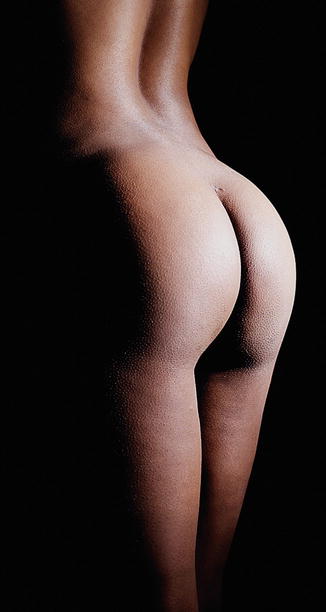

Fig. 15.1
Female buttocks
Stealth Incisions
Two main 5 mm incisions are used. The first is at the superior limit of the intergluteal crease that allows access to the superior gluteus, the lower back, and part of the mid gluteal area. The second incision is placed at the midpoint of the infragluteal fold. From here we can easily access the lower gluteal area and the internal and external posterior thigh (Fig. 15.2).


Fig. 15.2
Incisions with ports sutured in place on the superior intergluteal crease and over the mid inferior gluteal point bilaterally
The Use of Drains
A drain is used in the intergluteal incision, open or closed. Drains are not needed for the infragluteal incisions; on the contrary, when fat grafting is performed, it must be closed to avoid fat leakage.
Markings
The ideal buttocks have the shape of a hemisphere where the only defined edge is at the inferior-medial zone, whereas the rest of the borders blend seamlessly with the surrounding thigh and the torso.
The upper portion of the gluteal area is discussed in Chap. 14. However, it is important to remember the definition of the red and green zones.
Deep Markings
Mark the fat deposits that are located in the flanks, the sacral fat pad, the hips, and the lateral and medial thighs. These areas are going to be extracted by deep liposuction.
Framing
In females, the only areas for pure framing are the sacral dimples, but we have to establish a guideline for contouring after the deep extraction (Fig. 15.3) [2].
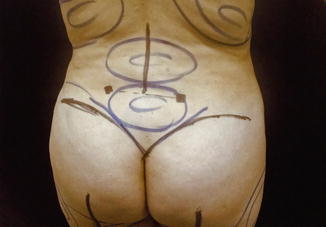

Fig. 15.3
Superior gluteal edge marking
We describe a simple but reliable classification of the zones to provide better contouring. We call them the green and red zones.
Identify the maximum point of indentation (PMI) (Fig. 15.4) in the waistline and trace a line to the upper limit of the intergluteal crease. Then, mark a line from this point to the superior iliac crest; this forms a triangular area we called the green zone where the fat can be freely removed (Fig. 15.5).
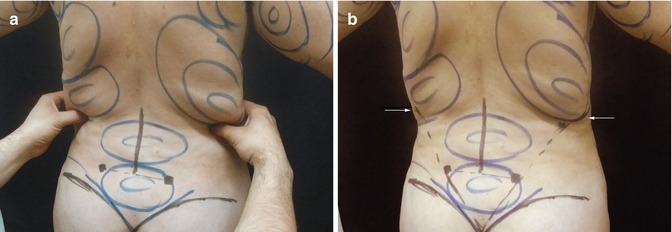
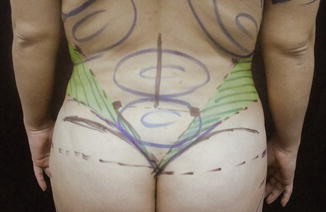

Fig. 15.4
Point of maximum indentation (PMI): (a) identification, (b) marking. The white arrows show that the PMI is asymmetric in this patient

Fig. 15.5
The green zone: free extraction area
Next, identify the trochanteric depression on the lateral side and trace a line from the top of the trochanteric depression to upper limit of the intergluteal crease. By doing this a new triangle is formed, the so-called red zone. The red zone is a transition area between the green zone and the trochanteric depression and requires gentle careful lipoplasty to a avoid overresection (Fig. 15.6).
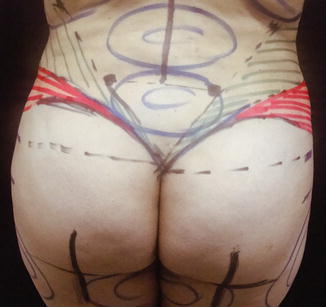

Fig. 15.6
The red zone: extract with caution to avoid overresection
The upper border of gluteus maximus delineates the lower border of the red zone. To find the border, ask the patient to contract the muscle and mark it.
Negative Spaces
Part of the upper aspect of the buttock lies inside the red zone, so the negative space of the red zone in the lower back must blend with the inferior limit of the red zone over the smooth convexity of the buttock. Similarly, the green and red zones must blend seamlessly with one another although liposuction in the green zone is more thorough in order to sculpt the waist near the PMI (Fig. 15.7).
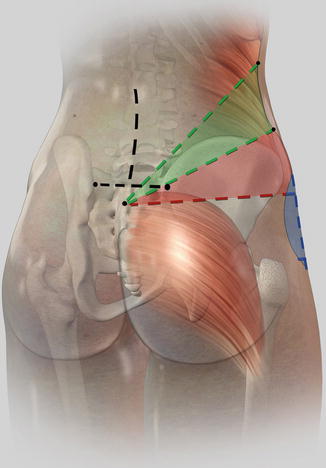

Fig. 15.7
Muscular landmarks and the green and red zones. The green zone is comprehended between the point of maximum indentation (PMI), and the iliac crest. The red zone between the lateral and the superior border of the trochanteric depression. The trochanteric depression is an area of fat grafting in female when it is visible (blue)
The inferior gluteal area is divided into four zones by tracing a vertical line from the center of the gluteus and a horizontal line that crosses through the infragluteal fold (Fig. 15.8):
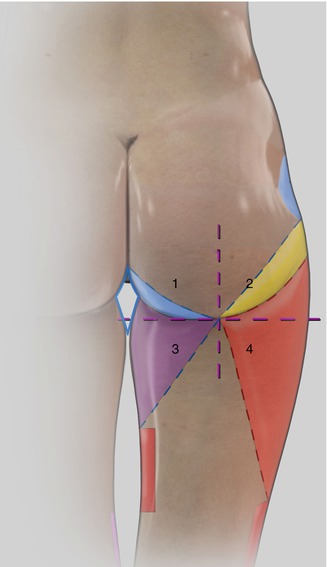

Fig. 15.8
Zones in the inferior gluteal area: 1 lower internal (light blue), 2 lower external (yellow), 3 inner thigh (purple), 4 outer thigh (red). Areas with colors do delimitate negative spaces for free and smooth liposuction. The inner thigh red rectangle shows the adhesion zone where lipo is prohibited
Zone 1, the lower internal gluteal area: It forms an acute angle in an aesthetically pleasant buttock, as stated by Mendieta [3
Stay updated, free articles. Join our Telegram channel

Full access? Get Clinical Tree








